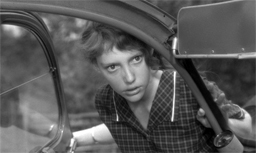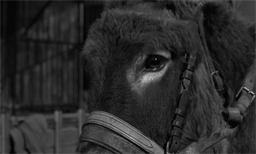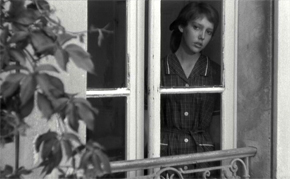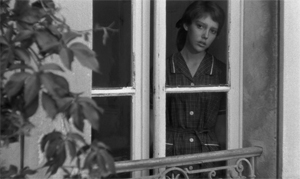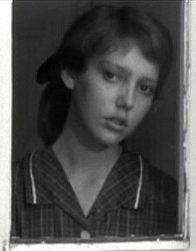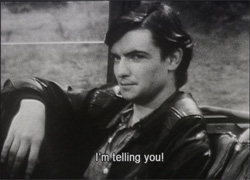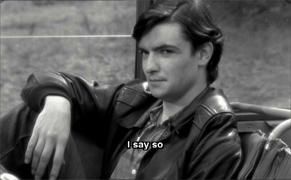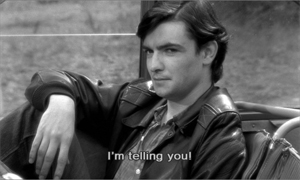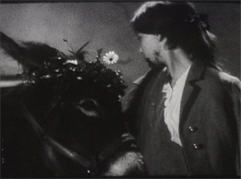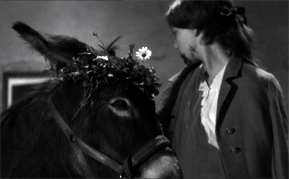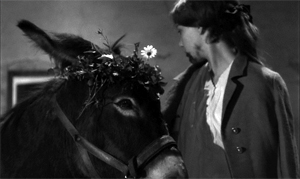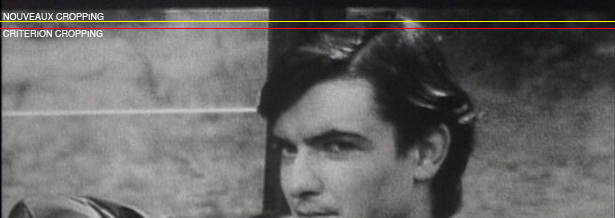
|
Doug Cummings and Trond Trondsen / robert-bresson.comAu hasard BalthazarRegion 1 DVD: Criterion Collection, 2005
The Film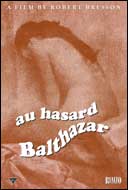
If Robert Bresson's aesthetic of realist, material sounds and images assembled in paradoxical ways virtually defines the cinematic parable, Au hasard Balthazar (1966) may be his most inspired and moving expression of the form. Presenting parallel narratives juxtaposing the lives of a teenaged girl, Marie (Anne Wiazemsky), with a donkey named Balthazar, the film is predicated on ellipses and reversals that occur between and within nearly every scene, confounding, subverting, and challenging viewer expectations. It's a narrative film, but its comprehension is less a matter of connecting cause and effect than speculating on the bits and pieces of information it assembles together in puzzling and evocative ways. The film has thus provided fertile ground for many thematic interpretations. Bresson himself acknowledged certain suggestions during the film's release on the French television program Pour le plaisir (included with the Criterion DVD): "This character resembles the Tramp in Chaplin's early films, but it's still an animal, a donkey, an animal that evokes eroticism yet at the same time evokes spirituality or Christian mysticism, because the donkey is of such importance in the Old and New Testaments, as well as ancient Roman churches." And yet Balthazar is far from a theoretical or intellectual exercise. ("Ideas gathered from reading will always be bookish ideas," Bresson wrote in Notes on the Cinematographer. "Go to the persons and objects directly.") The film's surface textures—farmland, piles of hay, a wooden swing, a spartan bench—are as lovingly emphasized as its sonic textures—Balthazar's braying, a creaking rope, various squeaking wheels. The film was shot by cinematographer Ghislain Cloquet, following Bresson's extraordinary four film collaboration with L.H. Burel, and it evokes the physical world with precise clarity. Combined with Bresson's downward-glancing, opaque models and evocative silences, the film offers an astonishing, muted beauty. Cloquet had previously worked on such films as Alain Resnais' Night and Fog (1955) and Jacques Becker's Le Trou (1960), and would shoot Bresson's two subsequent works. The film's sounds include a melancholy refrain from Schubert's Sonata No. 20, and although Bresson later rejected the use of nondiegetic music altogether (and suggested Balthazar's accompaniment was "too sentimental"), the film's music, like its imagery, provides effective counterpoint to its somber drama. Counterpoint is the driving force of the film. In the opening credits alone, Schubert's sonata is interrupted by a magnificent donkey bray. The first shot after the credits provides a composition of nature—a donkey colt suckling his mother—but a human hand intrudes from offscreen to pet the animal. Two children then ask an older man if they can have the colt and the man refuses; the next shot reveals the three of them leading the colt down a hill. The following scenes contrast the children playing on a farm ("baptizing" the donkey and naming him Balthazar) with a bed-ridden child who takes her medicine and quietly weeps. These gentle scenes then dissolve to a low angle shot of a man menacing the camera, cracking a whip with loud snaps on the soundtrack; it is years later and Balthazar is being put to work.
Throughout the film, Marie and Balthazar meet and diverge, seemingly at random (the film's title translates as "By Chance, Balthazar"). Suggestions of plot flicker in the background: Marie's father inherits a farm and takes great pride in putting it to use, but the old enemies of Bresson's Country Priest—distrust and gossip—isolate him from his small community; a murder occurs that implicates Gerard and his gang as well as the town drunkard, Arnold (played by Jean-Claude Guilbert, who, uncharacteristically for Bresson, would be reused in the director's next film); Balthazar is sold to various owners, all of whom invariably abuse the donkey as outward manifestations of unique vices.
The profundity of Balthazar—no doubt a primary reason why it was voted one of the top 20 films of all time in the 2002 Sight & Sound international poll—lies not in its fragments, however, but its overall harmony, the way Bresson fashions a sense of balance between suffering and beauty, will and passivity, exactitude and suggestion, chance and inevitability, life and death. His formal unity elevates the film to the highest artistic plane and its steady stream of contradictions appear as necessary truths, firmly placing the viewer between the knowable and the unknowable, the world that's perceived and the world that's hidden, intangibly ordered, and finally perhaps, revealed. —D.C.
The DVD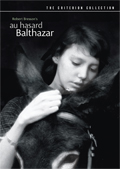
Criterion Post et al. have, of course, re-transferred, re-encoded, and redone the DLTs for this NTSC pressing, and so the very brief but unsightly digital pixelisation seen in the Nouveax release at 1:18:08 and at 1:23:41 (PAL time) is, thankfully, not present. However, the Criterion disc does have other encoding issues: a digital artifact rears its ugly head in the first two frames of each and every Chapter on the DVD. Take Chapter 8 as an example. The following are screengrabs of four successive frames from the film as encoded onto this DVD: (i) the last frame of the previous chapter, i.e., Chapter 7, (ii) the first frame of the new chapter, i.e., Chapter 8, (iii) the second frame of the chapter, and (iv) the third frame of the chapter. Click each image to enlarge. By examining these four images, it should become immediately apparent that the first two frames of Chapter 8 (and, indeed, this is the case for every Chapter on the disc) are essentially ruined. The effect, easily spotted when viewing the DVD on any good quality monitor, is somewhat less pronounced in the case of chapters which start with little or no motion in the image. Incidentally, this phenomenon is also afflicting Criterion's Diary of a Country Priest DVD [ sample screenshot ]. However, in the case of Diary, most chapters start with a fade from black, and the problem is for the most part hidden from the eyes of the viewer (which does not mean that the problem isn't there).Let us speculate on what could be causing this flaw (this paragraph may be considered optional reading). The problem is clearly associated with the Chapter Markers. Chapter markers can be incorporated into a DVD project in (at least) two ways: they can be prepared in advance and inserted into an MPEG stream as "forced" I-Frames. We suspect this is what Criterion have done. Maybe the encoder they were using lost cadence count near such forced I-Frames. Also, forced I-Frame insertion at the encoding stage can significantly alter the MPEG structure, resulting in an IPBP sequence (instead of the nominal IBBP), where the (predictive) P-Frames actually may be referencing an interlaced frame in the original material, if the original material was interlaced. The "interlaced" feel of the compromised frames are, we think, a tell-tale sign that Criterion may have based their transfer on interlaced material. (Please note carefully that the glitch is not necessarily a result of Criterion having used interlaced source material.) Finally, the second method of incorporating Chapter markers: they may be set later in the authoring process, using SMPTE Time Code, with a precision of 15 frames (PAL) or 12 frames (NTSC). In which case the MPEG natural structure (usually IBBP) is preserved intact. This is probably what Criterion should have done (if our theory is correct).
Conclusion: In spite of the encoding issue described above, we highly recommend the Criterion Edition as the
best English subtitled DVD version of the film available at this point in time.
Our recommendation stems in part from the fact that
this currently is the only edition not suffering from PAL speedup
(another pet peeve of ours); the film has a runtime
of 1:35:18, which is the correct duration (plus/minus the Criterion animated logo at the beginning), while the
Nouveax DVD clocks in at a mere 1:31:24, i.e., a 4% difference. The Criterion edition of the
film is somewhat cropped, but so is the Nouveaux version (more about that in the Appendix below).
The disc comes with superb bonus materials; the same cannot be said for the Nouveaux disc.
At only $21.56 from reputable online retailers, this purchase is a no-brainer. —T.T., June 2005
Appendix: Cropping Redux Fast-forward to June, 2005. Shortly after the release of the Criterion edition of Balthazar we were once again contacted by a representative of the Berkeley group, who in sheer horror pointed out to us the DVDBeaver review of the Criterion DVD, in which it is shown that the Criterion disc is cropped even heavier than the Nouveaux disc. We promised we would take a closer look at the matter. Our investigation was made somewhat easier by the fact that Criterion include on their disc a very interesting 1-hour French TV program about the film, called Un metteur en ordre: Robert Bresson, in which several clips from an old 1966 print of Balthazar are shown. These clips could now be used as a basis for verifying the Berkeley group's initial claim regarding excessive cropping. But first, a comparison of the Nouveaux disc to the Criterion disc, with emphasis on vertical cropping. The following figure shows one screen grab from each disc, the Nouveaux disc on the left and the Criterion on the right. Click images to see the full-size frame. A detail from the above scene—which was carefully composed by Bresson—is shown next. Notice how the Criterion disc does indeed provide a somewhat "closer shave" than the Nouveaux disc. There are certainly no major differences between the discs as seen in these image captures, but the hobby photographers among us will definitely appreciate the Nouveaux framing, as seen on the left.
Next, we show a frame grab from a clip of the film as shown in the Un metteur en ordre documentary included on the Criterion disc and immediately below this grab there is a frame grabs from the Nouveaux disc on the left and from the Criterion disc on the right. We do this for two different scenes, below. All images can be clicked for full-sized versions. The frame grabs from the TV documentary are presumably representative of what the film looked like when it was first screened in theatres in 1966 (at least as far as the vertical dimension is concerned). As can be seen here, the recent DVD editions show no fear of slicing off some hair—Criterion more agressively so than Nouveaux.
In the next figure, the yellow line indicates approximately where Nouveaux crops this very same image, and the red line represents Criterion's cropping. It is worth noting that both the Criterion and Nouveaux viewports move up slightly during the latter parts of the film (the Criterion viewport actually moves up to the location of the yellow line), the end effect being that hairdos are not as rampantly desecrated later on in the film (thus verifying another one of the Berkeley group's early impressions). The Berkeley group's initial claim that the DVDs are vertically cropped as compared to what was shown in the theatre therefore appears to be quite valid. But, how noticeable is it really? We give our friends in Berkeley the final word. Upon being presented with the "evidence" above, they responded as follows. "That's it exactly. By themselves the frames don't really convey the seriousness of the problem because one doesn't expect every shot comprising moving actors to perfectly frame the actors. But after a short while a viewer like me finds himself asking "Uh, why doesn't Bresson pull back just a couple feet and let me see actor's entire head into the screen — like he usually does." One comes away with the perception that Bresson suffers from a strange aversion to human hair. So, looking at these frames, I don't know if it's as "bad as I thought." Rather, "it is what it is": a frame from a film by a Master which has been edited down for reasons that are not clear to me but which, for lack of a better explanation, I ascribe to laziness and a tendency to adhere to some arbitrary formula rather than paying attention to what's on the screen. [...] These films are so great that is difficult to diminish their impact by a little bit of cropping. On the other hand, the films' greatness makes the loss of film image that much more irritating. In an ideal world, the DVD owner would get all the information on the frame and he/she could frame the image at home using his DVD player or computer [...]."
Acknowledgments: We wish to thank in particular Chris Ullsperger and Alex Asp for their contributions
to this review. Thanks also to Daryl Chin and DVDBeaver's Gary Tooze.
—T.T., June 2005
|

